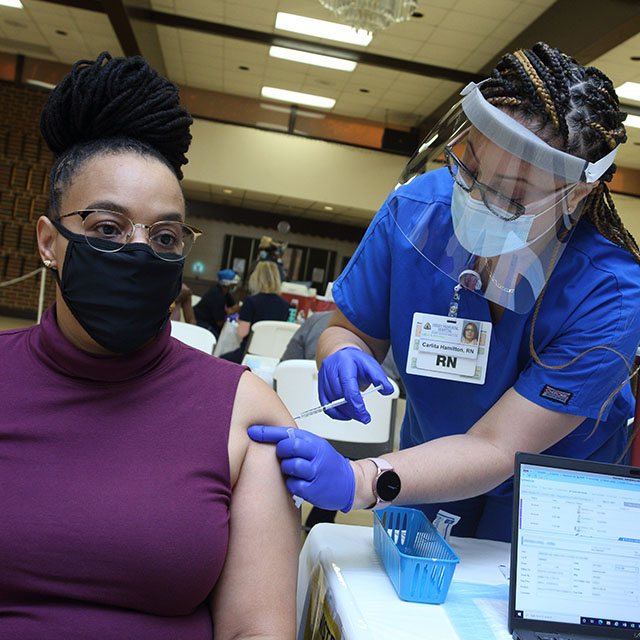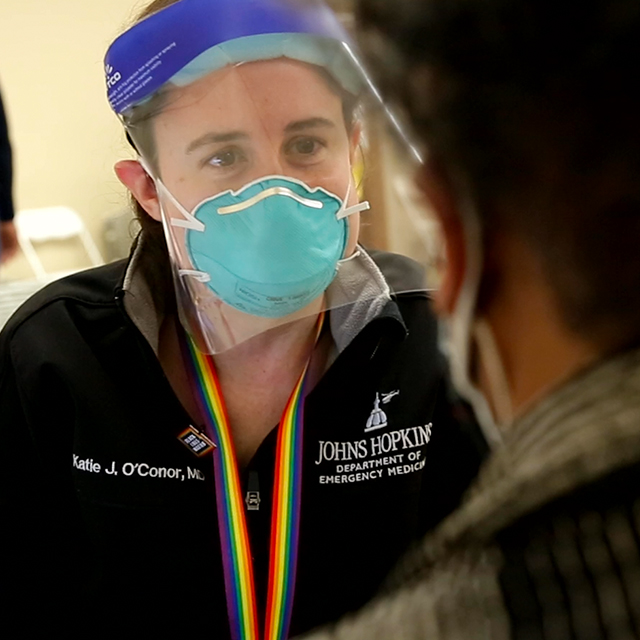Alejandra Flores-Miller walked into the East Baltimore barbershop and asked the owner to turn down the music so she could make an announcement.
Speaking in Spanish, she said that anyone who wanted a COVID-19 vaccine could get one: A Johns Hopkins Medicine clinic at the nearby Sacred Heart of Jesus Church had extra doses.
A few customers stood up, removed the towels draped around their necks, paid, and walked over to the church. “Twenty people were in the barbershop, and three went,” Flores-Miller later said.
She knows the owner, just as she knows most of the people working in the stores and restaurants of the largely Spanish-speaking neighborhood.
Flores-Miller, research program coordinator in the Division of Infectious Diseases, has been building relationships in the community since 2008, when she created a Latino Outreach Program for Johns Hopkins to connect residents with resources for preventing and treating HIV. Now she’s helping people get COVID-19 vaccines.
She’s part of a team, led by Centro Sol co-director Kathleen Page, that is organizing twice-weekly vaccine clinics at the church, on Mondays and Wednesdays starting at 4 p.m., in order to reach a community that has been disproportionately devastated by COVID-19. The Johns Hopkins group was already hosting COVID-19 testing at the church when it added the clinics in February 2021.
The group’s longstanding relationships are helping it bring COVID-19 vaccines to people who might not make appointments because of demanding work schedules, transportation challenges, language barriers or concerns about citizenship.
“The most important thing is that, from the moment you walk in to the moment you leave, you can speak Spanish,” says Page, an infectious disease specialist. “If you don’t speak the language, it can be intimidating. It’s hard to express fears or have questions answered through an interpreter.”
Starting in May, the Latino outreach team, clinicians and administrators have been holding walk-in clinics, with no appointment required. Participants can choose if they want the single-dose Johnson & Johnson vaccine or the Pfizer vaccine, which is approved for children 12 and older. “People are coming in with their kids,” says Page. “It’s great to see the whole family vaccinated.”
Each clinic needs a pharmacist, interpreters, administrators to register participants, and clinicians to give the vaccines. Kevin Sowers, president of the Johns Hopkins Health System and executive vice president of Johns Hopkins Medicine, has administered vaccines at several of the clinics, says Page.
About 200 people receive vaccinations at each session, says Page. If extra doses are available, Flores-Miller and other outreach workers spring into action to find people who can use them.
“We go where we know we’ll find members of the Spanish-speaking community, and we start explaining to people, giving them the information that we have so they can come and get vaccinated,” says Melissa Cuesta, a senior research program coordinator with the Division of Infectious Diseases.
If they hesitate, she doesn’t push.
“Sometimes when one person in a group says no, everyone says no,” she says. “But when you talk to them, they will be more likely to say ‘OK, I might think about it.’ One of the main questions they always ask is, ‘Did you get vaccinated?’ When we say yes, that gives them more interest.”
Page collaborates with local journalist Pedro Palomino, whose Somos Baltimore Latino website is a popular source of Spanish-language COVID-19 information in Baltimore. “Every Friday, I do a 30-minute ‘Ask your Doctor’ session with him,” says Page. “He has a huge reach. When we have extra vaccines available, we tell him and he tells his Facebook followers.”
People can also make appointments and get information through a bilingual hotline set up at the Esperanza Center, an immigration resource center, she says.
“I enjoy being at the clinics,” says Page. “It’s definitely satisfying. Last year we saw such a horrible impact in this community, and we are finally getting to the light at the end of the tunnel.”


